From internal pipelines, drains are transported by external ...


Repair in the bathroom is a costly and troublesome task. I would like to quickly finish the walls myself, at least save a little and choose a worthy replacement for the same tile. You can, of course, use various wall panels. But there is a more profitable option - a self-adhesive film for the bathroom, which is not afraid of moisture. A variety of drawings makes it possible to find a solution for any interior.
All high-quality self-adhesive films are made of PVC (polyvinyl chloride), which can easily tolerate even high humidity in the bathroom. In stores, they are sold in the form of rolls of various widths, from which you can cut a sheet of the desired length.
The vinyl film consists of three layers:
Prior to commencement of work, the glue layer is covered with special easily removable paper, which has a centimeter ruler to facilitate cutting.
There are monophonic films of a wide variety of colors, and with drawings, and stylized as ceramics, fabric, wood, leather.
They differ in surface type on:
Self-adhesive film in the bathroom can be used for pasting not only walls, but also ceilings and doors with furniture. There are many options, and for any style there is a solution. But various combinations of films with different appearance or landscape photographs look best.
And of course, lower cost in comparison with the same tile or other decorative options. It will only be cheaper to whiten or paint the walls.
For cutting you will need a knife and scissors, as well as a pencil, tape measure and a ruler. For gluing, you will need a household hair dryer, a spray bottle with soapy water and a rubber spatula.

The toolkit is simple, it’s easy to handle. Much more attention will have to be paid to preparing the surface to be glued. It must be just perfectly smooth. Otherwise, all flaws will be visible under the film. After all, although it is durable, but still quite thin.
Ideally suited for quality plastered concrete or brick surface. It is even better to use drywall, but it is worth taking care of carefully sealing and smoothing all the seams between the drywall sheets.
Plaster is applied in at least two layers: the main and the finish. The latter is polished with fine sandpaper to a perfectly smooth state and covered with a primer.
Applying a primer is mandatory. An acrylic primer is best suited, which will bind all the fine dust on the prepared surface and provide excellent adhesion. After priming, the self-adhesive film for the bathroom just sticks firmly and will hold for a long time.
When gluing a vinyl film on a metal, plastic, glass or oil-painted surface, you must definitely degrease it with any solvent.
Usually on the substrate there are explanatory instructions in the form of drawings. It is enough to follow them, and everything should work out.
Self-adhesive film for the bathroom can be used both as the main finishing material, and as an additional element of decor.
There is an imitation of all the basic natural finishing materials - wood, stone, leather. You can trim the mirrors, make platbands for lockers and doors, make applications in the form of cartoon characters or various ornaments. You can order a picture from your own photo or choose from the available images.
Self-adhesive film has been in demand among the population of our country for quite some time. With its help, you can not only make cute patterns, signs and accessories, but even complete repairs. Let's try to attach a self-adhesive film to the bathroom.
Self-adhesive film for the bathroom - a pretty good finish, especially if it is necessary to update the premises quickly and inexpensively. This material is simply applied to smooth surfaces, seriously changes the design of the room, is not afraid of humidity and is able to withstand temperatures up to 80 ° C. Moreover, you can always choose not only a single-color film, but also a material with ready-made drawings and patterns.
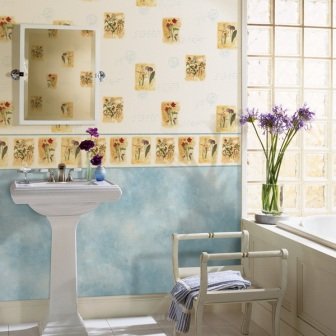
The good news is that a self-adhesive film for a bathroom can be applied to almost any material. This is metal, ceramic tile, wood, glass, plywood, plastered surface, gypsum, cork base, drywall.
The only drawback and the most stringent requirement is the application of a self-adhesive film only on a perfectly flat surface.
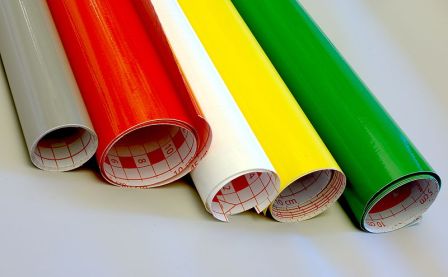
Nothing complicated and special, just the simplest set of tools: a pencil or pen for marking, a ruler (preferably long), an assembly knife for cutting, scissors for auxiliary cutting, an industrial hair dryer for heating, a doctor blade (felt material to help in the correct application of the film) or felt spatula.
It’s worth starting with preparing the surface, since far from every material the film will lie normally. Initially, the surfaces are well leveled and ground, then they are properly degreased and primed. The wood should be sanded and varnished, the metal should be given a high-quality primer, the gypsum board surfaces can simply be puttied and cleaned, the soil and the film itself applied. That is, in order to apply the film on the surface of the bathroom, you need to make the surface perfectly flat and degrease it so that the film adheres well.

Each type of self-adhesive is cut differently. For example, the most standard self-adhesive film in the bathroom is cut from the back, according to the layout of the substrate. A film with a special pattern, which you will need to fold from different strips or pieces of self-adhesive, is cut from the front side. From the “face” there is also a cutting of the film, which imitates ceramic tile.
For correct cutting, you will need measuring instruments, even a standard ruler, and a pencil. Further, after the final marking, the self-adhesive film is cut with a special knife, which we have already provided for in the set of our tools.

If you forget something, you can always look at the instructions during the operation itself, since the gluing scheme is indicated on the back of the film.
The substrate is neatly separated from the film by just a few centimeters, then the edge is applied to the markings on the wall, that is, to the place from which the pasting begins. After that, the substrate is gradually separated from the film, and the film is sequentially pressed to the surface, constantly leveled with a felt squeegee. The process of leveling and squeezing out air bubbles from under the film occurs from the center to the edges, so as not to make wrinkles on the film.
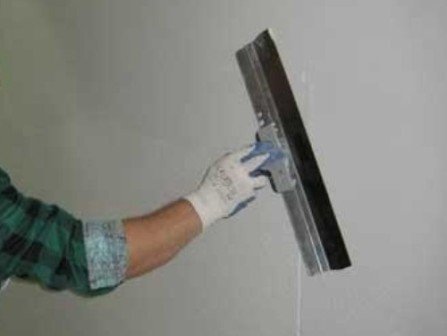
If you missed the bubbles when pasting, they can always be punched with a needle or the tip of a mounting knife and evened out by squeezing air from under the film and gluing it to the surface. If wrinkles form on the film, the film breaks off and sticks on again.
It often happens that we need to trim and align corners and lines - this can always be done with a sharp mounting knife. If you need to glue objects of irregular shape or, say, rounded elements, you can always slightly heat the film with a hair dryer and pull it in the right direction.
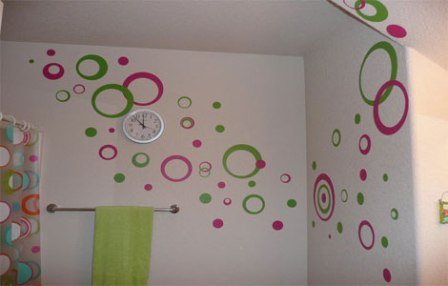
A hair dryer is also used to fix the results of the process. It warms up all the surfaces glued with a film.
If you need to paste metal, a plastic or glass surface with self-adhesive, we offer another rather interesting and quick way, which does not take a lot of time.
you need to moisten the surface of the material for gluing with soapy water (a solution of clean water and detergent). Next, you need to remove the entire substrate from the cut piece of film and attach the film to the surface. As you know, the material will not pester right away, and you will have a great opportunity to shift it in the right direction the required number of times. Having laid the film on the surface as you need, just gently press the upper edge of the film and expel all water from under it with a squeegee, downward, thereby smoothing the material on the surface.

Taped bathroom with self-adhesive film can be very fast, but now we need to do everything possible so as not to quickly lose her good looks and originality. For this, we are considering methods of film care.
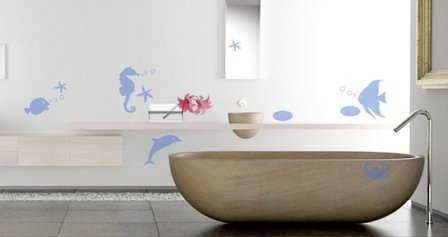
You will not have any difficulties, because the care of the film is very simple, you only need to wipe the material sometimes with warm water with detergent or ethyl alcohol if the dirt is not removed by simple cleaning.
Do not use abrasives and strong chemicals such as gasoline, acetone, solvents and others to care for the film.
As you can see, a self-adhesive film in the bathroom can be an option for an inexpensive and very original finish. Moreover, you can always glue the surface with a film yourself.
Do you want to equip a bathroom to your taste? Want to feel like a designer, but don't know where to start? Then a self-adhesive film for a bathroom is what you need. Ease of sticking, moisture resistance, resistance to high (up to 80 degrees) temperatures, the ability to choose your own color scheme - and all this at an affordable price. And easy dismantling will allow you to regularly change the situation in the bathroom.
In order to create an atmosphere in the bathroom to your taste with the help of a film, you need to choose the color scheme that will be combined with the other interior. It is advisable to choose a film color that will not contrast with other objects. For example, if the bathtub is made in a futuristic style, then the classic “square” film will hardly look beautiful. To emphasize cleanliness and “sterility” in the bathroom, a bright white film is suitable. To create an atmosphere of warmth and comfort, yellow and its shades are best suited. And if the bath or sink is painted in bright colors and it is necessary to emphasize them - dark tones. Colors and shades can be combined with each other. Often, diversity looks much better than monotony.
It is not necessary to paste over the entire room. The film can be combined perfectly with tiles and other materials. A very common technique is when the walls in the bathroom are tiled, and on the wall under which the bathtub stands, there is a picture of the sea or the wild landscape. This solution is suitable for visual expansion of the room. You can also use applications from the film on order or ready-made designer ones. And if the repair in the bathroom has already been done, but the pipes are uncomfortable sticking out in the corner, then the inconspicuous film in the color of the walls will perfectly cope with the task and save from unnecessary costs. The film on the ceiling with the image of the sky will give a sense of serenity. An old cast-iron bathtub can be given a modern look if it is “dressed” in a matte film.
Self-adhesive film for finishing the bathroom does not require special skills. If you need to apply "self-adhesive" on a flat surface, then this process will not cause difficulties even for a beginner. However, surface irregularities or corrugated tiles will have to be removed. When the film sticks out, it looks ugly. For installation, you will need a minimum set of tools:
First you need to prepare the surface. If possible, fix any irregularities with a primer. If the coating is wooden, then it is desirable to cover it with varnish. The best effect will be achieved by acrylic based primer. Immediately before gluing, the surface must be thoroughly degreased. Then you need to cut the film into small squares (the lines of squares are shown on the inside). When all the preparatory steps are completed, you can begin pasting.
Separate the edge (2-4 cm) of the substrate (paper back) from the film, then attach this edge to the base and smooth it straight with the squeegee from the middle to the edges. With one hand, holding the middle of the substrate, tighten it, and with the other, smooth the film. This must be done to minimize the appearance of air bubbles. Bubbles that still appeared should be pierced with a needle and then smoothed with a squeegee. Particular care should be taken when pasting corners. After the work is completed, the entire surface of the film must be heated with a hairdryer.
There is another gluing method that is best suited for glass or metal surfaces. The surface is wetted from the spray with a solution of water and detergent. Then you need to separate the substrate from the film and apply to a wetted surface. Further, from the middle to the edges, smooth with a squeegee, thus expelling water. It is best to do this together, although one person can handle it.
Further care for the film does not require much effort. In most cases, it is enough to simply wash the “self-adhesive” with warm water and a detergent. After cleaning, wiping the surface to dryness is not required. If serious pollution has appeared, then alcohol-based substances will help (even vodka is suitable). However, powder detergents or solvents are best avoided. Powders can scratch the film, and solvents can change its color.
So, a self-adhesive film is a material that combines ease of use, reasonable cost, the ability to creatively approach the issue of bathroom decor, ease of care. The pasting process is simple and easy. You can find the film on the shelves of almost all construction stores.
1. Unusual material that can have any surface (glossy, matte, smooth, rough). The range of colors and shades is simply amazing. In addition, you can choose not a single-color film, but various drawings, patterns, ornaments.
2. The price will please anyone who wants to make repairs, but does not have great financial capabilities.
3. Excellent quality characteristics: water resistance, durability, resistance to very high and low temperatures - up to 80 degrees.
4. You can do all the work on pasting the film on your own, without attracting specialists and without special skills.
Despite the huge number of advantages, do not forget about the disadvantages. There are not many of them, but you should not forget about them.
1. A rather laborious process of preparing the surface for gluing the film, it should be clean, dry and smooth.
2. Water resistance, of course, is an excellent quality for the finishing material for the bathroom, but the film does not allow the wall to not only get wet, but also breathe, so it is possible to form diaper rash and mold under it.
3. Fairly short life. For some, this is a drawback, but many people like to often change the interior in their apartment. Low price and easy installation will allow redecorating as often as your soul desires.
The film is sold in rolls from 45 to 90 cm wide and from 2 to 15 m in length.
Tape your entire bathroom with tape is a simple matter, but you are unlikely to like the result. Firstly, in large areas it looks ineffective. And secondly, sticking so much film on your own will be difficult. Do not forget that the entire surface will need to be carefully prepared - cleaned, leveled and dried.
But the film can become a spectacular decoration element. It easily covers various ledges and corners. A great idea is to hide and decorate the pipes in the bathroom. Since high temperatures and their differences are not an obstacle, you can close both the hot and cold pipes together. Designers advise to design pipes under the columns, for example, in the Asian style. For example, paste over a column with red paint and stick on top the cut out black hieroglyphs. The result is a beautiful and spectacular accent.
It’s easy to foil zoning the room with a film, for example, to finish the walls and ceiling with plain tiles, and to make the floor, bath and wall around the mirror and sink using a bright self-adhesive film with an interesting pattern.
What materials to glue. The undoubted advantage of the film is that it can be glued to almost any surface in your bathroom:
What tools will be needed. Pasting the film does not require you to have special and expensive tools, only a simple set of ordinary tools for repair:
1. Surface preparation for gluing. The base under the self-adhesive film must be thoroughly cleaned of dust and grease. The film will last a long time only on a smooth and clean surface. Degrease the surface with water and detergents.
The rough and porous wall will have to be primed. It is necessary to smooth uneven and cracked surfaces with putty. When drying, the wall is sanded and coated with a primer mixture. It is desirable that the base of the primer is acrylic, then the film will adhere as firmly as possible.
2. How to cut and prepare a self-adhesive film. On the underside of the film (wrong side of the paper), even squares are drawn, on which it is very convenient to cut it to obtain a piece of the desired size. First, measure out how much film is needed, mark the necessary lines with a pencil and cut them with an assembly knife. Do not forget to leave a margin of 2-3 cm on each side. If the film has a pattern of ceramic tiles or other geometric shapes, then it is cut from the front along the lines of the figures.
3. How to stick a film. On the reverse side of the film there is a manual for pasting, there all the works are schematically drawn. The substrate is separated from the film by no more than 3-5 cm, smoothly and very carefully apply it to the surface. The film is smoothed with a felt spatula or squeegee from the center to the edges, releasing all the bubbles and leveling the surface. Then, slowly, one hand removes the substrate from the film, and the other smoothes the self-adhesive in turn in different directions. This work procedure can save your wall from air bubbles. If after finishing all the work you notice several bubbles, pierce them with a thin knife or a thick needle and gently smooth with a squeegee. If you don’t have a squeegee, do not rush to the store to buy, you can take a piece of plastic and wrap it with a cloth. If a fold is formed during pasting, then you must immediately tear off the film sharply and forcefully and apply it again. This is possible because the film finally adheres to the wall after only a couple of hours.
4. Pasting corners, edges and completion of work. To paste over an even angle, the film is cut at 45 degrees, then it is folded and glued. For a round edge or convex surfaces, the film is first heated with a construction hair dryer, gently bent and glued. During heating, the film gains elasticity and lays well on an uneven surface
To achieve the best effect, repair professionals advise, after gluing, to heat the entire surface around the perimeter with a construction hair dryer, especially corners and joints.
If the surface to be glued has impressive dimensions (a whole wall), then wallpaper adhesive is first applied to it, so the film will hold more reliably. At the same time, the seams of the film are closed with silicone sealant to protect the adhesive base from moisture.
In the bathrooms, not only the walls are covered with a film, but they also make original accents on the details by gluing it to various materials: bathtub, glass, mirrors, metals and synthetic surfaces. To do this, pour detergent into the water and spray it on the desired surface. Then completely remove the entire substrate and apply the film on a wet basis. Set the film in the desired position, press and squeeze the water out with a squeegee, smoothing the film from the center to the edges. The main thing is that your detergent does not contain scratching components, solvent, gasoline and acetone. These components will spoil the surface or color of the film.
The film does not require regular daily care. Only if you need to remove dust or dirt can you make it a warm, damp cloth with a small amount of detergent added. If the pollution is very strong, vodka or ethyl alcohol will easily remove it.
So, self-adhesive film is a unique and modern material for decorating a bathroom, it is easy to fit, retains its shape and color for a long time, and has a very low price.
Today it is widely believed that self-adhesive film is a cheap substitute for ceramic tiles, which are traditionally used for decorating bathrooms. It should be noted right away that this point of view is absolutely wrong, since the self-adhesive PVC film is an amazing decorative finishing material, which, like ceramic tiles, has its own advantages and features. The use of a self-adhesive film is not a way to replace other finishing materials, but is intended to create a unique beautiful coating that cannot be done with other facing materials.
Self-adhesive film for the bathroom today is a widespread finishing waterproof material. It is made in different shades, may have a different surface texture, its price is affordable for any apartment owner, such self-adhesive is sold in most construction and hardware stores.
Self-adhesive film production is aimed at a wide consumer sector. This means that an important property of this material is not only low price, but also versatility of use. You can glue the walls with a self-adhesive PVC film of a suitable color and texture not only in the living room, but also in the office, trading company, educational institution, medical institution and other organizations. Self-gluing is relatively inexpensive, does not require additional expenses for the purchase of adhesive and allows you to quickly complete the lining of all necessary surfaces.
For sale this finishing material comes in the form of rolls. The surface of such a film can be smooth, matte, contain a textured coating or even embossing. Almost unlimited is the range of colors and patterns that self-adhesive can contain, which completely unties the hands of designers and opens up great opportunities for them. However, most often this material is used as a self-adhesive film for the bathroom, which is associated with a number of advantages and advantages, such as water resistance, resistance to pollution, temperature, and detergents, elasticity and low price. If you glue the bathroom once with such a film, this will be enough for several years of operation of the room without losing the attractiveness of the coating.

Photo coverage of PVC film of the walls of the bathroom provided to your attention in this article. There are practically no obvious shortcomings in this material, except for the fact that it should be glued to a perfectly flat wall. You can use this finishing material for surfaces such as gypsum, plaster, drywall, putty, wood (plywood), metal, glass and plastic.
Since the self-adhesive film does not require the use of an adhesive, and for cutting it does not need a saw, a grinder and other traditional tools, you only need:
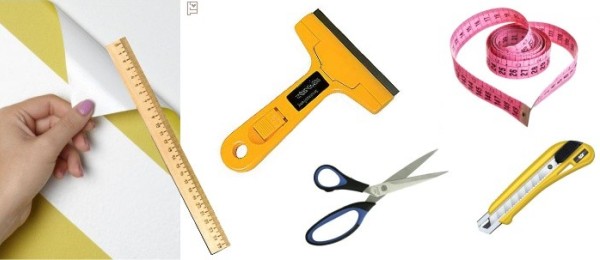
If in addition to this you have other tools that may come in handy, it is also advisable to prepare them, although the above should be completely sufficient to complete all the work. If you do not have a soft felt spatula, you will have to buy it at the nearest store, since it will be difficult to replace this tool.
Like all other facing works, gluing with a film of walls in the bathroom begins with preparatory work. They consist in cleaning and leveling the walls until a perfectly smooth and even surface is obtained. If stains from oily substances remain on the walls, you can use water and detergents to remove them. All places with a rough surface must be carefully sanded with sandpaper, after which, saturate all the walls with a primer. All cracks on the walls should be filled with putty, followed by grinding after it dries. To strengthen the surface of the walls, it is recommended to use acrylic primers, since they provide maximum adhesion strength of the self-adhesive film to the surface. If it is intended to stick a PVC film on glass or metal surfaces, they need to be slightly moistened.

After completing the preparatory work, you can proceed directly to the wall lining in the bathroom. On the back side of the film, after it has been deployed, a print in the form of squares is located. Thanks to this, it is very convenient to cut the material into pieces of the required size and shape. After marking with a marker and a ruler on the back, the rolls are cut into pieces according to the size of the walls. Self-adhesive is cut on a hard surface, pressing the ruler along the lines and holding a mounting knife near it. This process is well captured in the photo in this article. If there is a pattern or geometric figures on the front surface of the film, the pattern should be done on the front side, leaving a margin of 2-3 cm at the edges. If the surface of the film imitates ceramic tiles, it must be cut along lines that repeat the seams between the tiles.
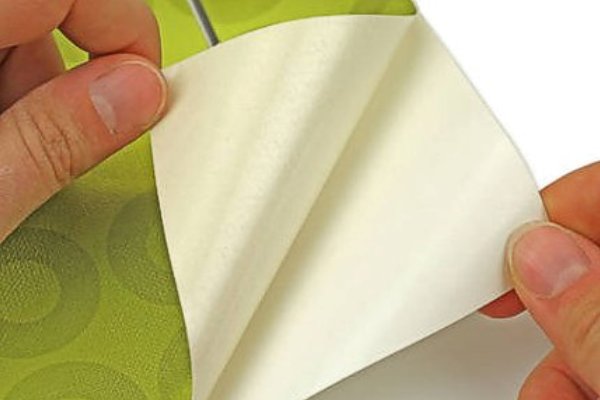
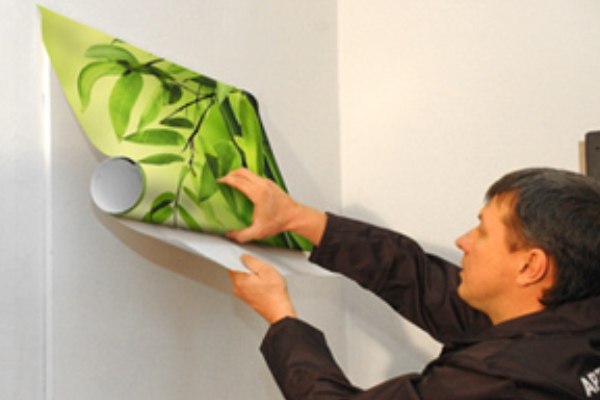
The process of sticking the film begins with its separation from the substrate. To do this, on the side from which gluing will begin, the substrate is separated by a distance of 2-3 cm and the edge of the film is very carefully and accurately applied to the wall in the right place. Then slowly with one hand we continue to pull on the substrate, separating it from the film, and with the other hand we smooth the self-adhesive film using a felt spatula. It must be remembered that smoothing the film should occur from the middle of the canvas to its edges. Gluing should be done slowly, slowly, separating the film from the substrate to the extent that it is glued to the wall. At this time, it is necessary to monitor the absence of air bubbles under the surface of the material, which should adhere uniformly and over the entire area.
Important tip! If you don’t have a felt spatula, you can use a plastic plate instead, wrapped around several layers of soft cloth.
If you suddenly noticed that wrinkles or wrinkles appeared on the surface of the self-adhesive film, you need to sharply pull the edge of the material and tear it off the surface, after which gluing and smoothing will be more carefully repeated. All defects must be corrected immediately, since after a few hours, self-adhesive can no longer be torn off the surface without damage.
To glue the inner and outer corners, the protruding edges of the film must be cut off at an angle of 45 degrees, bent and glued. Rounded edges that are more difficult to process are pasted over with a hairdryer. The device heats the film in the required place, after which it becomes very soft and elastic. In addition, with a hairdryer, it would be desirable to evenly warm all the walls after finishing them with film.
In fact, special care for taped walls in the bathroom is not required. All contaminants are easily removed from the surface of the material with a sponge, warm water and detergent. If, using this method, it was not possible to remove the stains, you can try to clean them with vodka or ethyl alcohol.
The only thing that is not advisable to use when caring for the cladding film is abrasive detergents in the form of a powder, as well as acetone-based solvents and gasoline. The use of the listed means may partially or completely damage the self-adhesive film.
Self-adhesive is a great way to quickly and beautifully finish a bathroom in any style. The decorative possibilities of the material are huge, the price is affordable, the decoration does not need any special care. Of course, it is not as durable as tile, and not as durable as stone, but repairs with it take a matter of hours. Yes, and the ability to periodically and very dramatically change the interior is hardly a drawback. Good luck with your repair!